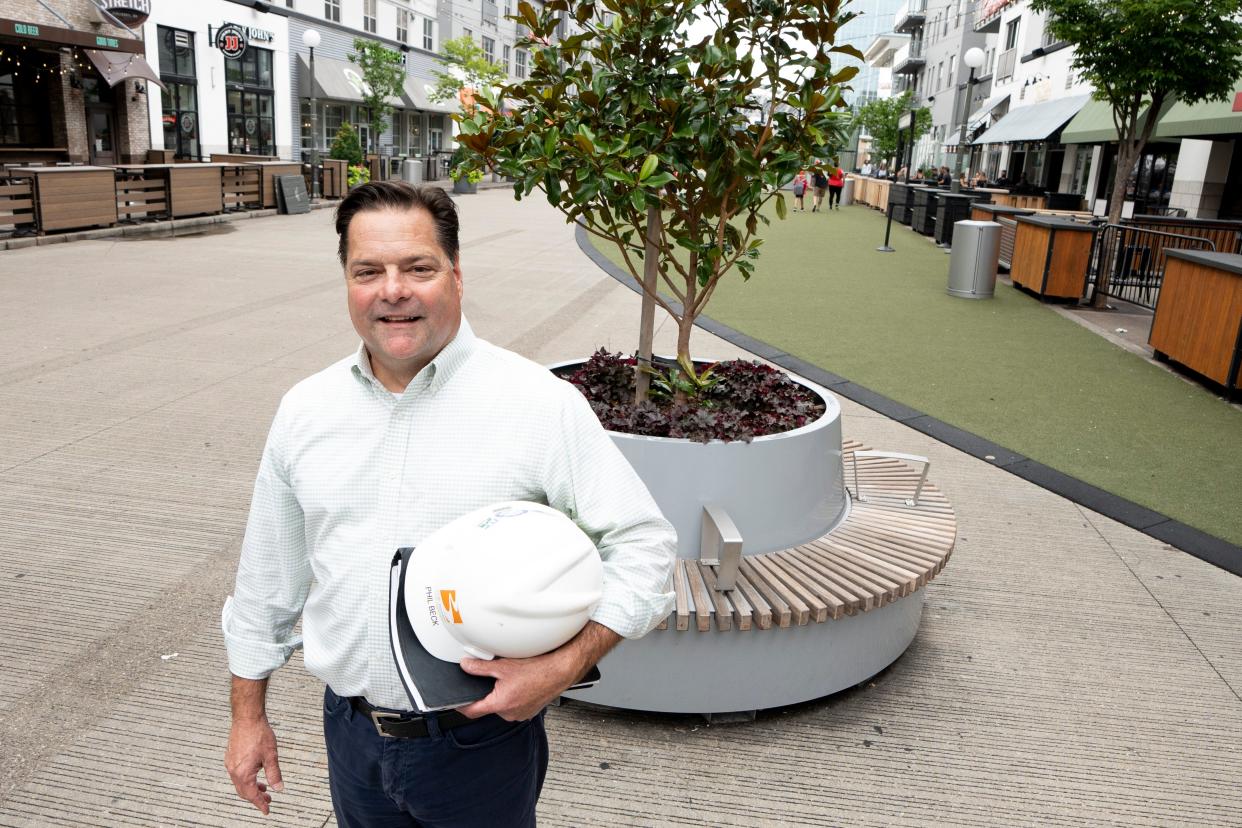'Banks 2.0?' What's ahead for Cincinnati's riverfront

This is part of The Enquirer's Future of Downtown series.
You may not know Phil Beck. But if you live in Greater Cincinnati, you probably have been to his domain.
Beck is the project executive for The Banks, the 18-acre complex of riverfront restaurants and residences that has been enjoying the national spotlight.
Tens of thousands of Taylor Swift fans sang and snapped selfies at The Banks earlier this summer. Then on July 22, the the Cincinnati Black Music Walk of Fame opened to fanfare, cheers and dancing.
Now Beck is leading efforts to finish The Banks – and then move on to "Banks 2.0," as he calls it.
The Enquirer sat down with Beck, 59, to discuss the future of the riverfront, how it's run and why the city and county needs someone to manage it.

What is The Banks?
It’s a development some have described as unlike any other in the country, involving a major city, county, park system, private developers and two major professional sports teams. Voters in 1996 approved a half-cent sales tax that paid for the construction of Great American Ball Park for the Reds and Paycor Stadium, formerly known as Paul Brown Stadium, for the Bengals. City and county leaders turned their attention to the mostly vacant land in between. The Banks broke ground in 2008.
Jim Moehring, owner of the Holy Grail sports bar next to Great American Ball Park, described the Banks as a “unicorn.”
“I don’t know of many places that are in the country that are in between two stadiums with apartments on top of them, with retail underneath and in a floodplain,” Moehring said. “It’s a pretty unique situation.”
What is left to do at The Banks?
The Banks still has room to grow over the next decade, Beck told The Enquirer.
Beck has managed development at The Banks on behalf of Cincinnati and Hamilton County for the past 10 years. His job will likely be around for at least another 10 years.
The Banks is 70% built, Beck said. It could take another five to 10 years to build out the rest.
There are five parcels left undeveloped. Most are parking lots right now. Two are ready for a developer.
Prior to the pandemic, the county unveiled large plans for two of these lots. A group of developers in 2018 proposed a $75 million to $85 million residential and commercial development for the largest undeveloped lot at The Banks near Paycor Stadium. In 2019, another developer proposed a 15-story office tower on a long vacant space at Second and Walnut streets next to the National Underground Railroad Freedom Center.
Both plans have stalled since the pandemic. The county still wants an office tower and a dense residential and commercial development on those lots, Beck said. For three parking lots around Paycor Stadium, the city and county have yet to come up with a plan, he said.
But The Banks may not end there.
Banks 2.0?
The Banks could grow by about 5 acres.
Cincinnati and Hamilton County are seeking money to put decks over Fort Washington Way to connect The Banks with the rest of Downtown Cincinnati. The decks could support 4 acres of parkland, two 0.7-acre bookend plazas and space for buildings up to four stories tall.
“I think it’s always been considered The Banks 2.0 is to build over the top of Fort Washington Way,” Beck said.
What is The Banks’ biggest need?
The biggest wish for business owners at the Banks is something that brings in more people. The weekday lunch crowd has not recovered to the pre-pandemic levels at the Holy Grail and other Banks restaurants, Moehring said.
The parking lots along the riverfront show the crowds haven't returned to their pre-pandemic levels. The county reaped $12.6 million in parking revenue in 2022, still down from $14.7 million in 2019.
The Banks needs more residential development and another hotel, he said.
“You know, before the pandemic, I would have told you 100%, an office building would help,” Moehring said. “I just don’t know if that’s feasible anymore.”
Beck said they haven’t given up on the development of an office tower.
“I think development is cyclical,” Beck said. “So it’s just a matter of, when is the right time?”
What is The Banks project executive?
So what role does Beck play in all this? He doesn't make the decisions. It’s Beck’s job to act as sort of a wrangler, or liaison, to those who do.
"Phil is the one who delivers the projects and he will oversee the construction,” said Hamilton County Administrator Jeff Aluotto. “He will work on getting the bids out, monitoring the bid packages, actually overseeing and reporting back on what is going on in the construction of the public infrastructure.”
Who makes the decisions at The Banks?
Ultimately, the nine members of Cincinnati City Council and the three members of the Hamilton County Board of Commissioners must approve what goes on the empty lots. They get a 50-50 say in the development of the lots, county and city officials told The Enquirer. But it isn't just them. Contracts signed over the past 25 years also give the Bengals and Reds ownership some say.
That was evident in the deal-making between the city, county and Bengals to pave the way for the Andrew J. Brady Music Center.
A group that included the Reds, Bengals and community leaders, called the Joint Banks Steering Committee, acted in an advisory capacity, making recommendations to city council and the county commissioners. The group, however, hasn't met in two or three years, said Charlie Luken, former Cincinnati mayor and member of the committee. Reds owner Bob Castellini, who led the efforts in building The Banks and was also on the committee, did not respond to a request for an interview.
What does he get paid?
Beck makes $187,000, the fourth highest salary of a county employee without a medical degree. (Pathologists at the coroner's office make more.)
Dealing with all these entities takes a certain expertise, officials have said. "There are only a handful of professionals in the country who can navigate the complex arenas of a project like this," then-Cincinnati City Manager Milton Dohoney said in 2008 when the position of Banks Project executive was created.
Who pays Beck's salary?
Ultimately, the taxpayers pay his salary. For the first several years of Beck's employment, the city of Cincinnati reimbursed Hamilton County for half of Beck's salary as project executive.
For the past two years, since county projects the Black Music Walk of Fame and building county parking garages have taken up a bulk of his time, the Hamilton County government has paid his full salary, Beck and Aluotto said.
Who is Phil Beck?
Beck is a licensed architect who worked in Baltimore and San Francisco before coming to Cincinnati in 2000 to work on the team that designed and built Great American Ball Park.
He also served in the Navy's construction battalion, known as the Seabees, from 1999 to 2019, including deployments to Iraq and Afghanistan where he managed construction teams.
Before working for the city and county, Beck managed the development of The Banks as an employee of the lead developer Carter & Associates from 2008 to 2010. The county and city hired him in 2013 to serve as the Banks project manager.
"I've seen quite a bit in my career," Beck said. "And I'm very familiar with city government and county government. And I am able to facilitate and get things done in an efficient manner."
Black Music Walk of Fame a big part of the job this year
For much of 2023, a large portion of his job has involved planning and coordinating the construction of the Black Music Walk of Fame, the project led by Hamilton County Commissioner Alicia Reece, according to Beck and based on texts and emails obtained through a public records request by The Enquirer.

Beck estimated it's taken up half his job this year.
"We have an extensive team of consultants on that project, due to the complexity, the interactive elements, in particular," Beck said.
The other half of his job in 2023 has been managing the development of a parking garage near Findlay Market, a project that was part of the deal that led to the construction of TQL Stadium for FC Cincinnati. The Enquirer asked the county for communications between Beck and county administration between March and June of this year to get a better idea of the job he's doing. They show Beck regularly updating the county administrator on the progress of both the garage and the Black Music Walk of Fame.
Why do the city and the county need an executive for one project?
The position was created by Cincinnati and Hamilton County in 2008 when engineer John Deatrick was hired from Washington, D.C., where he worked for the city's transportation department. Deatrick had previously worked for Cincinnati as transportation director and oversaw the reconstruction of Fort Washington Way in 1998.
They needed someone to make the city, county, sports teams and businesses work together, Deatrick said.
Deatrick pointed to the Black Music Walk of Fame as an example of why the project executive is needed.
"(Phil Beck) had to get that built, and, you know, keep the Bengals happy, keep the performance venue happy, not interfere with the parking," Deatrick said, "make all the utilities come together. And, you know, the technical aspects of all the technology that's involved in that."

How long has he been a township trustee?
Beck is also an elected official, serving as a township trustee since 2008 in Symmes Township, a suburban area in the northern part of Hamilton County. That job pays $22,000 a year.
Is it a conflict of interest?
Beck, county officials and township officials told The Enquirer they don't see a conflict with Beck both advocating for Symmes Township and the riverfront.
"I think there’s an advantage for the township in having someone familiar with who at the county level that we need to talk to to get things done," said Symmes Township Trustee Ken Bryant, "Having dealt with him for 16 years, I know his integrity is sound. I don't see anything as being an issue."

Who are the highest paid county employees?
The top 20 salaries in Hamilton County government, according to records from the county auditor.
Karen B. Looman, deputy coroner, $270,750.
Russell Uptegrove, deputy coroner, $258,050.
Jennifer Schott, deputy coroner, $258,050.
Dorothy Dean, deputy coroner, $258,050.
LeNora Godfrey, vice president of external affairs and interim chief financial officer for the Hamilton County Mental Health and Recovery Services Board, $249,658.
Gretel Stephens, deputy coroner, $238,050.
Benjamin Criss, deputy coroner, $232,879.
Anne Laib, deputy coroner, $217,350.
Jeff Aluotto, county administrator, $211,120.
Greg Kesterman, health commissioner, $189,000.
Phil Beck, Banks project executive, $187,782.
Holly Christmann, assistant county administrator, $174,408.
Raymond T. Faller, public defender, $169,124.
Michael Patton, director of Job and Family Services, $168,708.
Leia Snyder, superintendent of Developmental Disabilities Services, $167,614.
Jay Gramke, chief deputy sheriff, $164,587.
Ralph Linne, facilities director, $162,864.
Melissa Powers, prosecutor, $159,205.
Kathryn A. Ancona, senior attorney with the Hamilton County Public Defender's office, $157,851.
Andrew Beckman, manager of information systems, $156,750.
This article originally appeared on Cincinnati Enquirer: What is The Banks 2.0? A look at the future of the riverfront

